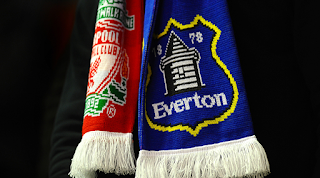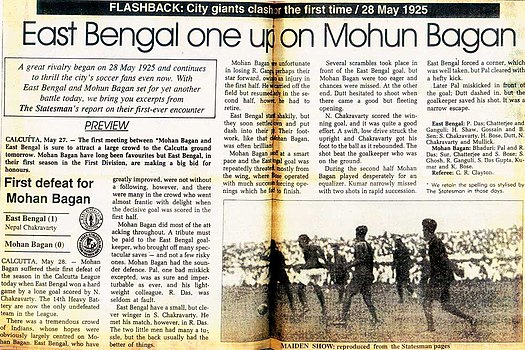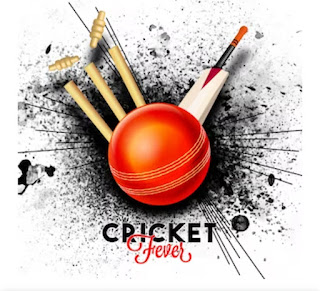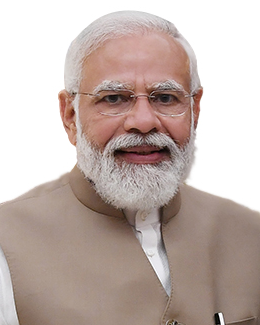THE MOHUN BAGAN VS THE EAST BENGAL DERBY
WHAT IS DERBY?
The most competitive matches in the Premier League are often 'Derby' matches. A 'derby' is a match between local rivals. i.e. teams that are from the same city or the same part of the country. These local games have a special place in the hearts of fans and players.
WHY IS DERBY SO IMPORTANT?
Local pride is the main reason, fans of both clubs see each other at school, work and sometimes even in the same family every day. When your club has won it is much easier to go to school or work the day after the game to boast about your team's victory.
Derby matches are often very difficult to predict as they are usually played at a very fast pace with lots of tackles and fouls. The Merseyside Derby is the fixture with most red cards in Premier League history. In every derby match, you will see lots of passion from fans and players as two local rivals go head to head for victory.
SOME OF THE MOST POPULAR DERBY ARE:-
THE MERSEYSIDE DERBY
The Merseyside Derby is played between Everton and Liverpool. It is called the Merseyside Derby after the River Mersey which flows through the city of Liverpool. The Merseyside Derby was first played in 1894 and has been played 221 times, with Liverpool winning 88 times and Everton 66 times. Everton and Liverpool football grounds are about 1 kilometre from each other and are the closest rival stadiums in the Premier League.
THE TYNE AND WEAR DERBY
THE WEST MIDLANDS DERBY
Aston Villa and West Bromwich Albion football clubs are only 4 miles (6.4 km) apart. Traditionally, Birmingham City and Wolverhampton Wanderers are their strongest rivals. However, those clubs are not in the Premier League so this match has become more important in the battle for supremacy in the West Midlands. This match has been played 141 times, with Aston Villa winning 65 times and West Brom 45 times. The first league meeting between the two teams was in 1889.
MOHUN BAGAN CLUB
The foundation of Mohun Bagan stretches back into the 1880s when the neighborhood youth of presently known Fariapukur Lane in Shyambazar had set out in search for an ideal place to establish a football club, and came across a marble palace, Mohun Bagan Villa, owned by the family of a leading jute trader, Kirti Chandra Mitra.
On 15 August 1889, after a meeting of three prominent aristocratic Bengali families of North Kolkata – the Mitra family, the Basu family, and the Sen family – presided over by Bhupendra Nath Basu himself, Mohun Bagan Sporting Club was formed. Bhupendra Nath Basu became the first president of the newly founded club and Jyotindra Nath Basu was the first secretary of it.
During the initial years, the meager ground inside the palace was used by the club for hosting matches, including their first match that was played against the team of Eden Hindu Hostel students, and lost 1–0. The club management hugely emphasized providing memberships to the youth and maintained a strict code of conduct with an avowed objective of producing excellent sportsmen and imbuing them with impeccable moral and social values.
At the first-anniversary assembly, the Presidency College students and members of the club invited their professor, F.J.Rowe, to attend. Rowe pointed out the inappropriate naming of the club and suggested replacing "Sporting" with "Athletic" since the club didn't indulge in sporting activities, like angling or rifle shooting. Thus, the members agreed and renamed the club as Mohun Bagan Athletic Club.
The second-anniversary assembly was presided by Sir Thomas Holland, who later became a member of the Executive Council of Governor-General of India. In 1891, with the help of the Maharaja Durga Charan Laha of Shyampukur, the club ground was relocated within his residential estate, now known as Laha Colony. The club ground was later relocated to Shyam Square in Bagbazar, with the help of the Kolkata Municipal Corporation chairman, Henry Lee. In 1900, Mohun Bagan became the partner of Presidency College and shared their ground at Maidan, where they would continue to play for 15 years.
EAST BENGAL CLUB
East Bengal was founded on 1 August 1920. It first started with just its men's football department but soon expanded into other sports such as hockey after 1947 and cricket in the 1970s. The women's football team was started in 2001.
East Bengal is one of the most widely supported sports clubs in Asia. The club is mainly supported by the Bangals, i.e., the immigrant population from the eastern region of Bengal, who were forced to leave their homes (modern-day Bangladesh) during the partition of 1947. For those people, East Bengal Club became a source of identity and hope. The huge influx of dispossessed into the state led to a socio-economic crisis.This led to rivalries among the immigrant and native population of West Bengal, popularly named as Bangal (বাঙাল) in every sphere of life, from jobs to schools and even on football, cricket and hockey pitches. As a result, East Bengal has a long-standing rivalry with its cross-town competitors Mohun Bagan, which is mainly supported by the native population, named popularly as Ghoti (ঘটি), with whom it competes in the Kolkata derby, Asia's biggest sports rivalry. East Bengal also shares a local rivalry with another Kolkata club, Mohammedan. The club dons the iconic red and golden yellow colours, which give it the nickname of Red and Gold Brigade and Laal Holud (লাল হলুদ).The fans of the club are also collectively called the Torchbearers.
On 28 July 1920, Jorabagan Club was scheduled to play against Mohun Bagan in the Coochbehar Cup. Jorabagan Club sent out their starting eleven but with the notable exclusion of defender Sailesh Bose, who was dropped from the squad for undisclosed reasons. The then vice-president of Jorabagan Club, Suresh Chandra Chaudhuri, asked in vain for Bose to be included in the line-up. When his request was not welcomed, Chaudhuri left the club along with Raja Manmatha Nath Chaudhuri, Ramesh Chandra Sen, and Aurobinda Ghosh. They formed East Bengal Club as a Sports and Cultural Association in the neighbourhood of Jorabagan on 1 August 1920. The name East Bengal was chosen for the newly formed club as the founders hailed from the eastern region of Bengal. Sarada Ranjan Ray took on the role of becoming the first president of this newly formed club while Suresh Chandra Chowdhury and Tarit Bhusan Roy were declared to be the first joint secretaries of the club. Soon after, Nagen Kali, M. Talukdar, B. Sen, N. Gossain, Goshto Paul (on loan from Mohun Bagan), P. Bardhan, S. Das, S. Tagore, J. Mukherjee, Ramesh Chandra Sen, S. Bose, C. Bose, A. Roy, and A. Bannerjee were announced to be the members of the first team squad by the board.
KOLKATA DERBY
The Kolkata Derby (locally known as "Boro Match") is the football match in Kolkata, between East Bengal and Mohun Bagan. The rivalry between these two teams is over 100 years old, and the matches witnessed large audience attendance and rivalry between patrons. It is considered to be one of the biggest Asian footballing rivalry. The first match was played on 8 August 1921 in Cooch Behar Cup and latest match of this historical derby was played on 10 March 2024 in Indian Super League. The Kolkata Derby is considered to be greatest derby in Asian Football and also one of the biggest derbies in the world.
The two clubs meet at least 3 times a year, twice in the Indian Super League and once in the Calcutta Football League. Often these two clubs met in other competitions like the Durand Cup, IFA Shield , Super Cup etc.
Both clubs have large and dedicated fan bases around the world, and represent a specific class of Bengali people, Mohun Bagan represents people existing in the western part of Bengal (known as Ghotis), while East Bengal is primarily supported by people hailing from the eastern part of pre-independence Bengal (known as Bangals). Culturally, this derby is very similar to the Scottish Professional Football League's Old Firm derby, since a majority of the Mohun Bagan supporters represent the 'nativist' population (similar to Rangers) and a majority of the East Bengal fans represent the 'immigrant' population (similar to Celtic). The celebrations of a derby win is traditionally marked with dishes prepared from either illish or golda chingri, depending on which team wins.The East Bengal supporters celebrate their win with ilish courses, being associated to the eastern region of Bengal (now Bangladesh), where as the Mohun Bagan fans celebrate with courses of golda chingri.
The 1960s proved a golden period for Mohun Bagan and it concluded in perfect fashion for the Mariners. Having already won the league, Mohun Bagan then did the double, defeating their rivals on their own ground in the IFA Shield final. The 3–1 victory credited to the then revolutionary 4–2–4 formation employed by innovative coach Amal Dutta.
The wheel eventually turned, and the 1970s was East Bengal's decade. The Red and Gold Brigade remained undefeated in the Derbies for 1932 days.In fact, they lost only one derby (that too outside Kolkata) in six years (1970 to 1975) which culminated in a 5–0 IFA Shield win over their great rivals. The Red and Golds won with a record 5–0 scoreline and, with it, a record of five consecutive Shield victories. Such was the ignominy surrounding the heavy defeat that several Mohun Bagan players spent the night holed up on a boat in the Ganges trying to escape the wrath of shell-shocked supporters. Umakanto Palodhi, an ardent Mohun Bagan fan, committed suicide. He wrote in his suicide note that in his next life he will born as a Mohun Bagan footballer and will take revenge of that 0–5 defeat.
On 16 August 1980, 16 football fans died due to stampede and riot inside the Eden Gardens stadium, Kolkata on the occasion of a Kolkata Derby match in the Calcutta Football League.
The tables turned again. Mohun Bagan won 8 derbies in a row scoring 16 goals in total thus humiliating the red and golds. The most memorable derby on many accounts took place in 1997 at the semi-final of the Federation Cup, when a remarkable crowd of 131,781 – a record attendance for any sport in India – filled a heaving Salt Lake Stadium. India's most recognizable footballer, Baichung Bhutia, took centre stage, scoring a hat-trick as East Bengal triumphed 4–1. In 2009, Mohun Bagan beat East Bengal 5–3 with Chidi Edeh scoring a hat-trick for Bagan.
On 6 September 2015, another memorable derby took place when East Bengal FC equaled the record for the highest margin of victory in a Calcutta Football League Derby as they triumphed 4–0 against Mohun Bagan. South Korean forward Do Dong-hyun scored a free-kick brace while Mohammed Rafique and Rahul Bheke scored the other two as the Red and Gold brigade matched their own record which they set back on 23 May 1936, when they defeated the Green and Maroons by the similar 4–0 scoreline with goals from Laxminarayan, K. Prasad, Murgesh and Majid.
On 29 January 2022, ATK Mohun Bagan beat East Bengal 3–1 scores with a hat-trick from Kiyan Nassiri, son of former East Bengal player Jamshid Nassiri, and became the youngest player to score a hat-trick in the derby. East Bengal lost six consecutive derbies since 2019— one in the Durand Cup, one in the I-League and the rest in the ISL.








Comments
Post a Comment